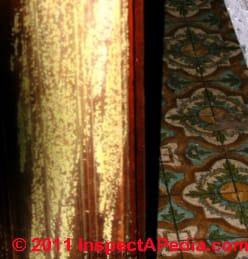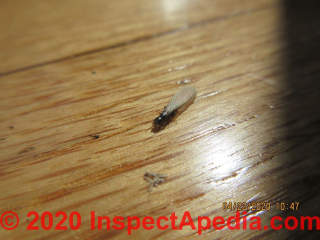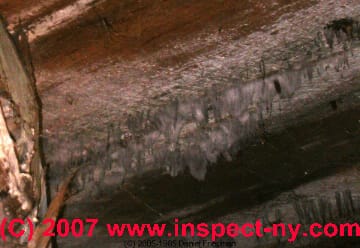 Meruliporia incrassata - "Poria" & Termites
Meruliporia incrassata - "Poria" & Termites
Symbiosis or Interference?
- POST a QUESTION or COMMENT about the relationship between termites and the house eating fungus: Meruliporia or Serpula molds in buildings
What is the relationship between termites that attack wood structures and Poria or Meruliporia fungus that can also cause rapid extensive damage and that may be found together with termites in some buildings?
This article series describes Meruliporia incrassata or "Poria" Meruliporia incrassata, previously named Poria incrassata which is better known among reporters and repairmen who see the public pale at reports of how the "house eating fungus destroys a home.
InspectAPedia tolerates no conflicts of interest. We have no relationship with advertisers, products, or services discussed at this website.
- Daniel Friedman, Publisher/Editor/Author - See WHO ARE WE?
Poria or Meruliporia and Termites
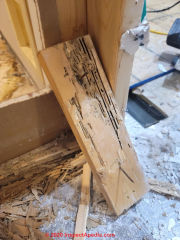 When attacking wood in buidings, do termites cause, or benefit from the presence of Meruliporia fungi, or are they repelled by "Poria" or other fungi? Research provides some interesting and sometimes contradictory answers, as we explain here.
When attacking wood in buidings, do termites cause, or benefit from the presence of Meruliporia fungi, or are they repelled by "Poria" or other fungi? Research provides some interesting and sometimes contradictory answers, as we explain here.
The water-conducting fungus, Poria incrassata (Berk. and Curt.) Burt, causes the most spectacular decay of wood in buildings in the United States. It produces large, tough, water-conducting strands (rhizomorphs) which, when rooted at a constant and abundant supply of moisture, can wet wood of a variety of species many feet away. - (Verrall 1968)
At page top we show an example of Meruliporia in an old building.
Question: Can Termites bring in or facilitate Poria?
2020/11/19 Chuck said:
I have extensive "poria" damage in our home. In addition to Extensive Termite damage. Basement construction. No water leaks.
Easily inspectible by competent termite technicians. It appears that Termites have been present for many years, more than 10 although responsible pest company never noted any termite activity.
[Click to enlarge any image]
Entire rear of house across 54' damaged, inwards around 13'. Basidiospores tested positive.
Question- Can Termites bring in or facilitate Poria?
The damaged wood clearly shows termites present prior to poria damage, as if to say that the poria was so aggressive it ran off the termites.
Regarding the next photo below:
Here is another picture of poria and termite damage together. Brown checking on outside of wood, termite mud inside of wood.
Moderator reply: Possibly but research suggests that Meruliporia repels termites
Chuck
Thank you for a helpful and interesting question about Meruliporia - or "poria" damage and its effect on termites.
I have found no scholarly research that blames poria damage itself on termites themselves nor vice versa though at least one of the references I cite below notes:
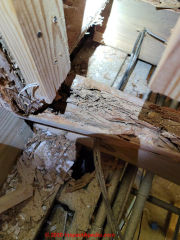 Some biologists, however, believe that the fungus so alters the structure of the wood that the termite is able to attack the wood. Other biologists feel that the wood itself, which the termites eat, does not supply proteinaceous material; and the termites cultivate the fungus in order to obtain the necessary protein for growth.
Some biologists, however, believe that the fungus so alters the structure of the wood that the termite is able to attack the wood. Other biologists feel that the wood itself, which the termites eat, does not supply proteinaceous material; and the termites cultivate the fungus in order to obtain the necessary protein for growth.
It has been discovered that, quite surprisingly therefore, termites may be repelled by the fungus Poria monticola. - (Lund 1966).
The building-environment conditions that invite termites might certainly also invite fungal contamination and rot, of which poria is one of the nastiest as it's rather hidden from view until it gets pretty bad.
And there is indeed evidence that the presence of Poria monticola, (and perhaps Poria incrassata) may repel termites!
A termite inspector doing probing might miss the meruliporia damage if she probes an area where damage is modest - spotting those mud tubes and missing the fine yellowish powder that is actually mold spores, characteristic of poria damage to wood.
Your suggestion that the "poria" drove off the termites is interesting and has merit. Kudos to you for thinking of it. In fact that theory has been expounded by entomologists and mycologists before (Lund 1966).
Once wood is sufficiently decayed it may be of no interest to termites as there's no stable passage to create through powdery muck, though I'm not sure experts would agree with me. (Matsuo 1973).
And meruliporia's by-products may indeed repel termites.
Nevertheless, nobody would want to permit their house to actually rot from meruliporia as a treatment for termites!
Reader follow-up:
2020/11/22 Chuck said:
First- thank you for a very thorough response. Due to ongoing litigation, I suspect this will be a hot area of debate.
I have attached a picture of an example of poria and termite damage coexisting [photos shown above - Ed.] (At least at some point in time)
Not sure if you can tell, but the pic shows termite damage and you can see white on the same piece of wood.
I wonder if the fungi is brought in from the termite tubes?
The tube in fact protecting the termites but also spreading the fungus. Everywhere there is termite damage, there is fungus.
Moderator reply: relationship of termites & Meruliporia sp. fungus
Above: yellow poria fungus in a New York home and termite mud tubes and damaged wood framing. Poria damage and termite damage may overlap in a building.
Chuck, I've certainly found Meruliporia damage in buildings where there we could not see evidence of accompanying termite damage, but note this remark:
Some biologists, however, believe that the fungus so alters the structure of the wood that the termite is able to attack the wood.
Other biologists feel that the wood itself, which the termites eat, does not supply proteinaceous material; and the termites cultivate the fungus in order to obtain the necessary protein for growth. (Lund 1966) ( Nobre 2010) (Korb 2003)
It is also worth noting that Poria incrassata damage can occur rapidly and often in new construction.
Records on the occurrence of Poria incrassata in houses are summarized in table 3. When the attacks occurred most of the houses were only a few years old or had received recent structural changes. This circumstance strongly supports the view that infected lumber is an important means of introducing the fungus into buildings ( 19, 24, 25, 51 ).
Baxter ( 3 ) suggests that the occurrence of P. incrassata in the North may be largely due to the importation of infected lumber. Very likely infected lumber is not the only means of spread.
The house at Dothan, Ala ., had a recent addition but the decay started in an older part where a coal pile on wet soil had been in contact with the siding. The fungus may have been introduced on the coal. The infection was adjacent to the bathroom, where a plumbing leak constantly wetted the substructure and allowed the fungus to exist after the coal had been removed .
...
For all the houses listed in table 3, the probable points of entry were:
- Dirt fills 21 percent of the cases ;
- wood piers 21 percent ;
- joists and sills 21 percent ;
- wood on groundline concrete slabs 15 percent ;
- siding and sheathing 12 percent ;
- forms for concrete 6 percent .
- In the remainder the point of entry was not apparent .
Constant sources of moisture were :
- Soil, 78 percent of the cases ;
- rain seepage, 16 percent ;
- moist concrete, 12 percent ;
- leaky plumbing, 9 percent.
Sometimes two or more factors were operative . - (Verrall 1968)
The surface of the soil was wet under 56 percent of the houses with crawl space, moist under 8 percent, dry under 12 percent, and undetermined under 24 percent .
Drying the crawl space by drainage is safer than reducing humidity with a soil cover.
The fungus can maintain itself in wet soil under a cover ( 12 ) and will attack covers containing cellulose fibers ( 1 ).
Crawl - space ventilation was less important than previously suspected. Ventilation was good under 68 percent of the houses, fair under 16 percent, and poor under 16 percent. However, some of the most destructive attacks occurred where the crawl - space soil was wet and ventilation was poor.
Severe damage was found in houses with the best substructure ventilation, i. e ., open - pier foundations, but here an abundance of water was supplied by well - developed rhizomorph systems . - (Verrall 1968)
A remote inspector is never a substitute for an onsite expert, but it's possible that I can see and comment on details in your photos that may be useful.
What are the conditions under which the two photos were taken? In particular, has only demolition been done to expose damage, or have some repairs already begun? I ask because I see what looks like newer material in some areas of your photos.
What is the specific point of disagreement or litigation?
Reader follow-up: issue of inadequate termite inspection / treatment
2020/11/23 Chuck said:
What are the conditions under which the two photos were taken? In particular, has only demolition been done to expose damage, or have some repairs already begun?
Yes- damaged wood in some load bearing walls was removed and temporarily repaired in Jan 2019. We only recently opened up much larger areas that exposed additional damage. We will not repair, or possibly replace the structure until a determination has been made in our case.
What is the specific point of disagreement or litigation?
We constructed the home in '99. Hired a Termite pest control company for pre-construction treatments. Then paid them annually for termite inspections up until damage discovery in Oct 2018.
House sits on an unfinished basement. A porch was added to rear of the home in 2006. Their position is that because the porch was added and they did not treat the porch, they have no responsibility for the damage.
We contend they are 100% responsible for the termite damage and any other associated damage as result of poor inspection practices. There are many facts in this matter supporting our position that I should not get in to here at this time.
The piece of 2x4 in the picture standing on end was installed in 2016 when we remodeled our Kitchen. That is 4 years ago and you can see how much termite damage occurred. Is is roughly 12' to the interior of the home from the foundation wall. The poria adjacent was not present to our knowledge at the time of this remodel. Yet the surrounding floor structure is covered and growing an active basidiospore in this area. So, how did it get there?
[Below abstracted from private email]
One of our termite experts is of the opinion that termites do not cause Meruliporia infestation in buildings, as “… Poria requires a water source to remain active. Termites do not provide enough moisture for that to happen” …
Our engineer is of the opinion that termites do bring or could facilitate “poria” infestation.
Moderator reply:
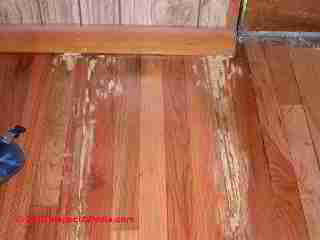 Illustration: yellow "material" and termite damaged wood flooring studied by the author and discussed
Illustration: yellow "material" and termite damaged wood flooring studied by the author and discussed
Chuck
Your added details are helpful. What follows is OPINION based on the limited data at hand in this discussion.
Hiring a contractor for pre-construction treatment telegraphs that most-likely everybody involved knew that the home was being constructed in an area of Virginia or at a particular neighborhood prone to termite-attack.
I haven't seen any details about how this home was built but if it were my project I'd have taken steps to make the home as resistant to termite attack as I could, including choice of materials, termite shields, and attention to drainage, roof runoff control, water and moisture control, use of treated wood in higher risk locations such as sills and lower walls (resistant doesn't mean a termite won't build a mud tube over a PT wood sill).
The addition of a porch can restrict access to and so limit treatment of an area of a building. Failure to warn you of that problem and possibly failure to construct the porch to either provide access or to make the building structure termite resistant are disappointments.
The question of whether or not the inspector's services were deficient in finding and addressing active termite attack surely must be determined by the inspection history, the termite and Meruliporia damage history, and where damage appeared for visual detection and when.
The building is located in Virginia between Richmond (my home town - DF) and Williamsburg, an area of temperate climate. In that area the termites commonly found are either the eastern subterranean termite or the formosan termite. Either of these can cause very extensive damage to wood structures.
---- from private email ----
I remain professional neutral in discussions and disputes like this one, as key to retain credibility. With the reclama that of course I can't be as smart as your onsite experts, I comment:
Below are some comments based on what you've described about the building and its inspection history and on your posing a question of the relationship of termites and Meruliporia and whether or not the termites "brought in the Meruliporia" to the building, for which you report having got conflicting opinions.
1. Stating that "Poria requires a moisture source" and "Termites don't provide enough moisture for Poria" might let one infer that termites do not "cause" Meruliporia infestation but: Termites don't have to "bring in the water" to support Meruliporia.
The particularly onerous feature of this fungus is that it can travel great distances inside wood members, far from its water source, though it still requires a moisture source.
That source can be quite remote from the extremes of the damage. It is unnecessarily confusing and probably not useful to pursue the water argument to decide who came first, termites or fungus. Moisture or water affect both. If both are present there is or was a moisture source.
In sum we should not be surprised to find all three situations:
- Meruliporia sp. in wood without termites present,
- Termites in wood without Meruliporia present,
- Both Meruliporia and Termites present in wood
2. Termites *might* indeed bring in or cultivate Meruliporia in wood, as you can read in some of the scholarly research on this topic going back at least to the 1960s and that I cited earlier, but that research did not claim to be conclusive.
There is research pointing out that the fungus might both help (digest wood making it easier for termite consumption) and hinder (repel termites by chemicals) termite presence in wood, so unless we find some additional or more-recent and more-conclusive research the resulting answer should remain inconclusive.
And there is absolutely evidence that termites have been shown to cultivate other fungi in their colonies. So it’s not a spurious claim.
3. Meruliporia damage occurs without termites
I have absolutely found extensive Meruliporia damage in wood structures where termites were not present
4. Termite damage occurs without Meruliporia sp.
I have absolutely found termite damage in wood structures where we found no Meruliporia - just how common that fungus is in homes probably varies by geographic area as well as, of course, individual building conditions.
Our photo of a swarming (winged) termite crawling across the finished floor in a home is provided courtesy of New Jersey home inspector David Grudzinski.
5. Moisture is key, along with wood-soil proximity or contact, aided by sheltered attack paths - the fungus prefers dark spaces to ones that are well-lit.
Temperature ism also a factor in the activity of both organisms, and it is possible that where Poria and termites co-habit wood in a structure the temperature-regulating effect of the termite colony may help keep the temperature within the narrow range required by Meruliporia for active growth just as the heat of fermentation in the fungus may support the temperature preferred by termites [opinion-DJF based on ( Lüscher 1961)].
But for both termites and fungal infestation in buildings, moisture is a key. Sometimes significant and pointed out by Verra (1968),
Sometimes the source of constant water occurs away from the point of initial attack. For this reason just fixing an outside or building perimeter water problem is not alone a reliable control for Poria infections.
For termites, probably more than for Meruliporia wood-soil contact or wood-soil proximity are key determinants. We find termite mud tubes on the outside, inside, and even inside concrete block or in cracks in poured concrete reaching up from soil into wood structure, but having inspected thousands of buildings and seen lots of insect and mold or fungus damage, I emphasize that proximity of wood to soil and moisture or water sources is highly correlated with any wood destroying insect attack,
while on the other hand, in general where mold contaminates or infects a building, the moisture source can be anywhere, more subtle, and wood-soil proximity is not a determinant.
6. Which came first Mold or Termites?
I am doubtful that a mere visual inspection of wood can possibly determine "who came first" the termites or the fungus.
These are completely different organisms that for a host of reasons may propagate in wood at very different rates over different intervals, affected by many external conditions (temperature and moisture, being the two key ones).
Poria is killed in wood at temperatures ... considerably below those required for commercial kiln-drying of lumber, [30 min. at 50C]. (Verrall 1968)
High moisture is also required to sustain the fungus.
The rot caused by Poria incrassata is often called “ dry rot, ” presumably because the fungus, by conducting water, attacks wood that is normally dry. During active decay, however, the wood is moist to the touch.
Decay caused by many other fungi in wood made wet by rain seepage is also called dry rot. Between rains the wood so attacked may be dry for long periods ( 50 ), during which these infections remain dormant. In contrast, P. incrassata survives only a short time in dry wood. Regardless of the fungus alluded to, the term dry rot is a misnomer.
Poria incrassata is extremely sensitive to drying. It was viable in only 53 of 105 samples of rotted wood received at the U. S. Forest Products Laboratory. In naturally infected wood, it could not survive 32 days of air - drying.
All artificial infections were dead in 1 day at 30 percent relative humidity, in 5 days at 65 percent, and in 10 days at 90 percent ( 42 ). Findlay and Badcock ( 20 ) reported that both P. incrassata and Merulius lacrymans are sensitive to drying .
In contrast, such fungi as Lenzites trabea and L. saepiaria lived at least 9 years in wood at 12 percent moisture content. (Verrall 1968)
The same author noted that Poria incrassata tolerates some fungicides but ....
Practical significance of the tolerance to copper fungicides is uncertain. No failures of preservatively treated wood in buildings have been reported. In soil - block and stake tests the treated wood was subjected to attack under conditions more conducive to decay than are likely to occur in buildings.
At present, there is little justification for excluding any com monly accepted preservative in construction. In repairing damage by Poria incrassata, however, wood treated with a noncopper fungicide should be used . (Verrall 1968)
7. Stop the fungal and termite attacks & repair the damage
Watch out: Waiting too long to stop ongoing damage of a building during litigation might raise a new issue that the building was not perserved or damage interrupted so the damages were unnecessarily increased; discuss this with your lawyer.
To stop the Meruliporia infestation most-likely you will need to remove infected wood close to any moisture source as well as wood that is sufficiently damaged as to no longer be functional as structure, flooring, etc..
Because of the way that fungus spreads distant from its moisture source (up to 25 ft) that can mean extensive demolition, basically removing badly damaged, wet material as well as infected perimeter material near any water or moisture.
For some more-sophisticated wood testing methods see the articles listed starting
at WOOD STRUCTURE ASSESSMENT - home
To stop a termite infestation we usually rely on cutting off the termite path to ground (presuming yours are termites coming up from soil, as there are some exceptions to that passage)
(I remove infested wood, add shields, fix the moisture source, repair with treated wood) and typically the contractor wil have a professional apply chemical poisoning of the soil - your termite expert will be able to advise you on termite control for the repired building.
(Notice that they no longer use the word "exterminate" but rather "control" - a distinction that in my opinion is significant in forming one's expectations.)
But a WDI inspector may not alone be equipped to assess the extent of damage to the structure - you'll need an experienced repair contractor who knows how to recognize damage and how to help you decide how much damaged material must be removed.
For legal and resale purposes you'll want to keep a thorough and well-documented record of what work you have performed.
8. If you want to pursue the termite-fungus distinction you've made, which IMO is not likely to be helpful and may simply confuse a court until it’s tossed out, you might want to try contacting some of the mycologists and entymologists who work in the field.
I'm unclear why the which-was-first argument is critical in deciding how to proceed.
If your dispute is about accountability for the discovery of or reporting of termite damage there are usually far less fragile arguments available to sort that out.
I hinted at this line of reasoning when I asked about what looks like pressure treated or new lumber in some of your photos. (You answered that - you’re the original owner, it’s new work, and there were regular ongoing WDI inspections).
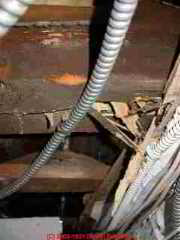 9. Should an inspector have seen and reported termites?
9. Should an inspector have seen and reported termites?
An expert inspection of a building can usually find unambiguous visual evidence of conditions that indicate wood destroying insect infestation; finding Meruliporia damage is more difficult until the damage is rather advanced, but at that advanced state that, too, is visually obvious.
Often building inspectors and termite inspectors will probe high-risk areas or suspicious areas of wood framing, though during a pre-purchase home inspection a home inspector would not be expected to probe any finished-surfaces where such might cause even cosmetic damage unless that investigation has been agreed-to by the building owner.
Details are at TERMITE DAMAGE PROBING
Knowing of the possibility of Meruliporia infestation and having examined its spores in the lab Iearned to be alert for “yellow dust” in buildings.
For example I found yellow “dust” on the floor of a kitchen sink base cabinet, confirmed in the lab that it was Meruliporia incrassata spores, and ultimately correlated that dust with extensive Meruliporia damage in the building. [By the time you find such spore dust deposits you can bet the fungal infection and so the damage are well-advanced.] That dust would not be a Meruliporia alert to most building inspectors.
Having fielded and adjudicated complaints involving home inspectors and others for a long time it is my opinion that we can state what's reasonable to expect something like this:
Standard of Due Diligence in Building or Termite Inspection Reporting
If, at the time of an inspection for condition "X" there was clear, unambiguous visual evidence, without having to perform destructive or invasive examination, that condition "X" was present, such that all the inspector had to do was direct his or her eye towards it, then the inspector employed for that purpose should have seen it and reported X and has fallen down on the job if X was not reported.
Exacerbating conditions also can arise, such as using an inspector who has conflicting interests with the client, for example a buyer is taking a chance when using a home inspector referred by a real estate agent (who is obligated to the seller).
You are welcome to print and make use of articles we've published on these topics as information sources; my credentials are at the website About InspectApedia.com page. But I am not and don't represent myself as a Meruliporia expert though I am indeed familiar with the topic as I've discussed and researched and written about it extensively.
Reader follow-up:
Chuck said:
..., absolutely incredible response! This helps tremendously. I will be sure to follow up as we proceed.
I do agree with your assessment that we must protect/preserve what is left.
Based on our new uncovered evidence, that is in fact what we are working on now.
For anyone who encounters this fungi, I can only hope and pray they take the necessary steps immediately to reduce additional damage and exposure. Unfortunately, I am finding there are little to no experts in our area.
This has made this matter challenging in our particular situation. Thank you for this FREE and HIGHLY EDUCATIONAL website. And thank you even more for your valuable time. -Chuck
Research on the Relationship Between Fungus, Poria or Merulipoira & Termites
Illustration: the symbiotic relationship between some species of termites and some white rot fungii has been widely studied; some of that work is cited below. This illustration is from Ohkuma et als (2001).
[Click to enlarge any image]
- Aanen, Duur K., H. Henrik, Alfons JM Debets, Niels AG Kerstes, Rolf F. Hoekstra, and Jacobus J. Boomsma. "High symbiont relatedness stabilizes mutualistic cooperation in fungus-growing termites." science 326, no. 5956 (2009): 1103-1106.
- Aanen, Duur K., Paul Eggleton, Corinne Rouland-Lefevre, Tobias Guldberg-Frøslev, Søren Rosendahl, and Jacobus J. Boomsma. "The evolution of fungus-growing termites and their mutualistic fungal symbionts." Proceedings of the National Academy of Sciences 99, no. 23 (2002): 14887-14892.
Abstract excerpts:
We have estimated phylogenies of fungus-growing termites and their associated mutualistic fungi of the genus Termitomyces using Bayesian analyses of DNA sequences.
Our study shows that the symbiosis has a single African origin and that secondary domestication of other fungi or reversal of mutualistic fungi to a free-living state has not occurred. Host switching has been frequent, especially at the lower taxonomic levels, and nests of single termite species can have different symbionts.
... Despite repeated host switching, statistical tests taking phylogenetic uncertainty into account show a significant congruence between the termite and fungal phylogenies, because mutualistic interactions at higher taxonomic levels show considerable specificity. We identify common characteristics of fungus-farming evolution in termites and ants, which apply despite the major differences between these two insect agricultural systems.
We hypothesize that biparental colony founding may have constrained the evolution of vertical symbiont transmission in termites but not in ants where males die after mating.
- Clausen, Carol A., and Katie M. Jenkins. "Chronicles of Fibroporia radiculosa (= Antrodia radiculosa) TFFH 294." General technical report FPL-GTR-204. Madison, WI: US Dept. of Agriculture, Forest Service, Forest Products Laboratory, 2011: 5 p. 204 (2011).
Excerpt:
... a long active growing season for decay fungi and termites … is used to rate each stake until it fails from fungal decay or termite damage … All three isolates, initially identified as Meruliporia incrassata, - De Groot, Rodney C., Bessie Woodward, and Paul E. Hennon. "Natural decay resistance of heartwood from dead, standing yellow-cedar trees: laboratory evaluations." Forest products journal. Vol. 50, no. 1 (Jan. 2000).: p. 53-59: ill. (2000).
- De Groot, Rodney C., and Bessie Woodward. "Using copper-tolerant fungi to biodegrade wood treated with copper-based preservatives." International biodeterioration & biodegradation 44, no. 1 (1999): 17-27.
- Feng, Hanmeizy. "A Preliminary Report On The Comparative Tests Of Termite Trail-following Pheromone Analogues From Fungus-infected Wood [j]." Acta Entomologica Sinica 3 (1980).
- Freeman, Mike H., and Craig R. McIntyre. COPPER BASED WOOD PRESERVATIVES [PDF] Forest products journal 58, no. 11 (2008): 6-27.
Excerpt:
Several brown-rot wood decay fungi in the genera Serpula and some species that were once included with in the genus Poria are tolerant of copper (De Groot and Woodward 1999) - Green III, Frederick, T. A. Kuster, Les Ferge, and Terry L. Highley. "Inhibition of wood decay and termite damage by calcium precipitation." Document-the International Research Group on Wood Preservation (Sweden) (1996).
- Korb, Judith. TERMITES [PDF] Current Biology 17, no. 23 (2007): R995-R999.
Excerpt: The exact role of the cultivated fungus seems to differ between species, but its primary function is to break down complex chemical substances from plant material, such as lignin, and make them available for the termites.
The termites reciprocate by providing the fungus with a haven of pre-processed food, and a competitor-free environment with optimal temperature and humidity conditions.
This allows the fungus to grow all year and through dry periods, providing the termites with a year-round, nitrogen-rich food source. - Korb, Judith, and Duur K. Aanen. "The evolution of uniparental transmission of fungal symbionts in fungus-growing termites (Macrotermitinae)." Behavioral Ecology and Sociobiology 53, no. 2 (2003): 65-71.
Abstract excerpts:
... In the fungus-growing termites (Macrotermintinae) horizontal transmission seems to be the rule as the termites normally acquire their cultivated fungus (Termitomyces) from the environment. In spite of this general pattern, uniparental, vertical transmission has evolved in two unrelated Macrotermitinae genera, where only one sex of the two primary reproductives carries asexual spores from the fungal comb of its parent colony to inoculate the new fungus comb.
Remarkably, symbiont transmission is exclusively paternal in Macrotermes bellicosus, whereas symbionts are maternally inherited in all Microtermes species studied so far.
... Despite this fundamental difference both groups evolved a similar symbiosis that is probably the key for their ecological success: the fungus-growing ants in the neotropics and the fungus-growing termites in the paleotropics. - LI, Xianwen, Yurong ZHANG, Jiewei CHEN, and Xiaodan YU. "The prevention and control termites technology during cultivation period of Poria cocos." Hunan Forestry Science & Technology 5 (2007): 16.
- Lund, Anders E. CONTROLLING TERMITES with a FUNGUS [PDF] U.S. Patent 3,249,492, issued May 3, 1966.
Excerpt:
It is well known that fungi may develop troughout the burrows of termites. The relationship between fungi and termites has not been completely es tablished, however. One theory holds that the fungus alters the structure of the wood and thus enables it to be attacked by the termites. Another theory is that the termites cultivate the fungus in order to obtain protein for growth.
A still further theory is that the conditions which are conducive to the growth of fungi are also con ducive to the growth of termites and their close associ ation is merely accidental.
It has been found that, quite unexpectedly, the wood. decaying fungus Lentinus lepideus is antagonistic and extremely lethal to termites, The fungus Lentinus lepideus is widely distributed. It has the remarkable characteristic of tolerance to com paratively high concentrations of creosote.
- Lund, Anders E. REPELLING TERMITES WITH THE FUNGUS PORIA MONTICOLA [PDF] U.S. Patent 3,249,493, issued May 3, 1966.
Excerpt:
Fungi may develop profusely throughout the burrows of termites. The ecological relationship between fungi and termites is not entirely known. The conditions which are conducive to the growth of fungi are also conducive to the growth of termites. Their close association may therefore be purely accidental.
Some biologists, however, believe that the fungus so alters the structure of the wood that the termite is able to attack the wood. Other biologists feel that the wood itself, which the termites eat, does not supply proteinaceous material; and the termites cultivate the fungus in order to obtain the necessary protein for growth.
It has been discovered that, quite surprisingly therefore, termites may be repelled by the fungus Poria monticola.
The fungus, Poria monticola, is frequently present in soft-wood lumber. Particularly susceptible to this fungus is Douglas-fir and Sitka spruce which has been shipped in an unseasoned condition and then stacked in solid piles without proper ventilation.
The infection may be present in the form of spores which develop if the lumber remains damp. It has been reported as a cause of dry-rot in buildings but it is usually confined to moist basements.
Normally, in lumber, the first indications of the presence of this rot are faint streaks or elongated patches of yellowish-brown or pinkish-brown discolorations. The wood seems to be brittle in that the fibers break off short and do not splinter it tested with a pen knife. The culture on a 2% malt agar forms a uniform soft woolly mycelial mat.
At first, the culture is white but later may assume a brownish cast sometimes with a pinkish tinge. - Lüscher, Martin. "Air-conditioned termite nests." Scientific American 205, no. 1 (1961): 138-147.
Excerpt:
Where the termites cultivate fungi, the heat of fermentation in the fungus combs suplies still more warmth ... - Matsuo, Haruo, and Koichi NISHIMOTO. "The Consumption of the fungus-infected wood by termite, Coptotermes formosanus Shiraki." (1973).
Excerpt:
The pine wood blocks decayed by 7 brown rot fungi, the decayed and ether extracted blocks and the sound wood blocks were set on the nest of the termite, and the weight loss (%) of each test piece was calculated.
The ratio of the weight loss (the decayed wood/the sound wood, the decayed and ether extracted wood/the sound wood, or the decayed wood / the decayed and ether extracted wood) were also calculated.
The higher the degree of decay on the test pieces was, the higher the weight loss of the decayed blocks by termites was, and in some pieces the weight loss reached near 100%.
The wood consumption of the decayed and ether extracted blocks by termites mostly ranged 30% to 60%.
In both the decayed blocks and the decayed and ether extracted blocks, the consumption of sapwood by termites was generally higher than that of heartwood. Judging from the ratio, both the decayed blocks and the decayed and ether extracted blocks were eaten more than the sound blocks.
The higher the weight loss due to decay was, the higher the ratio of the weight loss of the decayed blocks to that of the sound wood was. The ratio of the weight loss of the decayed and ether extracted wood to that of the sound wood, for the most part, ranged from 1 to 3. - Miller, Dini, SIGNS of SUBTERRANEAN TERMITE INFESTATION [PDF] Virginia Cooperative Extension, Virginia Tech / Virginia State University, retrieved 2020/11/23 original source: https://www.pubs.ext.vt.edu/444/444-501/444-501.html
- Mohareb, Ahmed, Marie France Thévenon, Edmond Wozniak, and Philippe Gérardin. "Effects of polyvinyl alcohol on leachability and efficacy of boron wood preservatives against fungal decay and termite attack." Wood science and technology 45, no. 3 (2011): 407-417.
- Money, Nicholas, P. PLAGUES UPON HOUSES AND CARS: THE UNNATURAL HISTORY OF MERULIPORIA [ODF] GEOFF GADD is Professor of Microbiology and Head of the Division of Environmental and Applied Biology at the University of Dundee.: 289. Department of Botany, Miami University, Oxford, Ohio
- Nobre, Tânia, Corinne Rouland-Lefèvre, and Duur K. Aanen. "Comparative biology of fungus cultivation in termites and ants." In Biology of termites: a modern synthesis, pp. 193-210. Springer, Dordrecht, 2010.
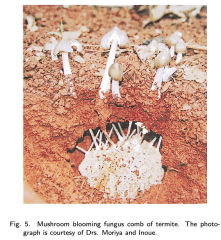
- Ohkuma, M. "Termite symbiotic systems: efficient bio-recycling of lignocellulose." Applied microbiology and biotechnology 61, no. 1 (2003): 1-9.
- Ohkuma, Moriya, Yoshimasa Maeda, Toru Johjima, and Toshiaki Kudo. LIGNIN DEGRADATION AND ROLES OF WHITE ROT FUNGI: Study on an efficient symbiotic system in fungus-growing termites and its application to bioremediation [PDF] Riken Review (2001): 39-42.
Abstract:
White rot fungi produce extracellular phenoloxidases and can decompose lignin efficiently. Elfvingia applanatahas been successfully applied for the bioconversion of bisphenol A, suggesting the usefulness of white rot fungi for bioremediation. In order to attain real bioremediation, the recycling of ecomolecules in the ecosystem is important.
The sophisticated symbiotic system of white rot fungi of the generaTermitomyces with fungus-growing termites is an attractive example of an efficient natural system to be studied, in which cooperationbetween termites and fungi accomplishes efficient decomposition of lignin and complete biorecycling of plant litter.
Excerpt:
This group of termites has an interesting symbiotic relationship with ba-sidiomycete fungi of the genusTermitomyces, such that they cultivate the symbiotic fungi within their nests. In sometypes of fungus-growing termites, the “termite mushroom”, the fruiting body of Termitomyces, blooms seasonally from termite nests (Fig. 5). The termite mushroom is unique in nature, growing from only the termite nests. - Quijian, L., Z. Junhong, and Liu Bingrong. "BEHAVIORAL & FEEDING RESPONSE of Coptotermes formosanus (Isoptera: Rhinotermitidae) to pine sawdust inoculated with five fungus species [PDF] in The Third Conference of Pacific Rim Termite Research Group Guangzhou, PR China 6 and 7 March 2006. 2006.
Abstract excerpt:
For each fungus species, termites were observed aggregating into sawdust infected with fungus and termites showed strong feeding preference for the fungus-inoculated sawdust for all fungus species tested in paired choice tests. - Radek, Renate. Flagellates, bacteria, and fungi associated with termites: diversity and function in nutrition–a review [PDF] Ecotropica 5, no. 1 (1999): 183-196.
- Rouland-Lefèvre, Corinne, and David E. Bignell. "Cultivation of symbiotic fungi by termites of the subfamily Macrotermitinae." In Symbiosis, pp. 731-756. Springer, Dordrecht, 2001.
- Royes, Joy, and A. R. Loveless. "Poria carbonacea (Berk. & Curt.) Cooke as a cause of timber rot in Jamaica." Transactions of the British Mycological Society 43, no. 3 (1960): 571-577.
- Smythe, R. V., H. C. Coppel, and T. C. Allen. "The responses of Reticulitermes spp. and Zootermopsis angusticollis (Isoptera) to extracts from woods decayed by various fungi." Annals of the Entomological Society of America 60, no. 1 (1967): 8-9.
Excerpt:
The western subterranean termite, R. hesperus, did not respond strongly to any of the fungi … Termites Fungi R. flavipes Lenzitcs trabca -f- Lcntinus lepidcus L. trabca + Dacdalca qncrcina L. trabca … f I), qucrcina L. lepidcus + I), qucrcina R. virginicus Lenzitcs trabca - Verrall, Arthur Frederic. PORIA INCRASSATA ROT: PREVENTION AND CONTROL IN BUILDINGS. No. 1385. [PDF] US Department of Agriculture, Forest Service, 1968. Available as a free eBook courtesy of Google, at https://play.google.com/books/reader?id=YaMoAAAAYAAJ&hl=en&pg=GBS.PA1
This bulletin reviews the literature on Poria incrassata and summarizes 30 years of experience with its control in the South. ...
The water - conducting or building Poria was first described as Merulius incrassatus by Berkley and Curtis in 1849 from a sporophore on a pine stump in South Carolina. - Additional research is atReferences or Citations at the end of this page.
- Also see TERMITE DAMAGE PROBING
...
Continue reading at MERULIPORIA HOUSE EATING FUNGUS - topic home, or select a topic from the closely-related articles below, or see the complete ARTICLE INDEX.
Or see these
Recommended Articles
- HIDDEN MOLD, HOW TO FIND
- MERULIPORIA HOUSE EATING FUNGUS
- MERULIPORIA DAMAGE - What does Poria look like? Why do Meruliporia or Serpula House-Eating Fungi Cause So Much Damage to Wood Structures?
- MERULIPORIA under the MICROSCOPE - Photographs of Meruliporia incrassata in buildings and under the microscope
- MERULIPORIA DAMAGE MECHANISM - Details about how Meruliporia incrassata causes rot & how it grows in buildings
- MERULIPORIA FUNGUS REMEDIES - What to do about Meruliporia incrassata when it is found in a building - how much wood to remove?
- PORIA DAMAGE PREVENTION - how to prevent Poria or Meruliporia "house eating" fungus damage to wood structures
- MERULIPORIA vs SERPULA - What is the Difference Between Meruliporia incrassata and Serpula lacrymans? Many Poria names, some describe the same organism or members of its family.
- MERULIPORIA FUNGUS & TERMITE INTERACTIONS
- MOLD APPEARANCE - WHAT MOLD LOOKS LIKE - home
- MOLD ON DIRT FLOORS - where we have also identified Poria fungus.
- STRUCTURAL DAMAGE PROBING
- TERMITE DAMAGE PROBING
- TERMITE IDENTIFICATION & CONTROL
- WOOD STRUCTURE ASSESSMENT
Suggested citation for this web page
MERULIPORIA FUNGUS & TERMITE INTERACTIONS at InspectApedia.com - online encyclopedia of building & environmental inspection, testing, diagnosis, repair, & problem prevention advice.
Or see this
INDEX to RELATED ARTICLES: ARTICLE INDEX to MOLD CONTAMINATION & REMEDIATION
Or use the SEARCH BOX found below to Ask a Question or Search InspectApedia
Ask a Question or Search InspectApedia
Try the search box just below, or if you prefer, post a question or comment in the Comments box below and we will respond promptly.
Search the InspectApedia website
Note: appearance of your Comment below may be delayed: if your comment contains an image, photograph, web link, or text that looks to the software as if it might be a web link, your posting will appear after it has been approved by a moderator. Apologies for the delay.
Only one image can be added per comment but you can post as many comments, and therefore images, as you like.
You will not receive a notification when a response to your question has been posted.
Please bookmark this page to make it easy for you to check back for our response.
IF above you see "Comment Form is loading comments..." then COMMENT BOX - countable.ca / bawkbox.com IS NOT WORKING.
In any case you are welcome to send an email directly to us at InspectApedia.com at editor@inspectApedia.com
We'll reply to you directly. Please help us help you by noting, in your email, the URL of the InspectApedia page where you wanted to comment.
Citations & References
In addition to any citations in the article above, a full list is available on request.
- Verrall, Arthur Frederic. Poria incrassata rot: prevention and control in buildings. No. 1385. US Department of Agriculture, Forest Service, 1968.
- Alexopolous, C.J., C.W. Mims, M. Blackwell. 1996. Introductory Mycology, 4th ed. (or later) John Wiley & Sons, New York. 869pp.
- Kirk, Cannon, David, and Stalpers, "Dictionary of the Fungi," 9th Ed.
- Meruliporia incrassata references: web search 4/24/11, Wikipedia and other sources:
- Index Fungorum entry for Meruliporia incrassata (Berk. & M.A. Curtis) Murrill 1942, (also see Species Fungorum: Meruliporia incrassata); Coniophoraceae - http://www.indexfungorum.org/
- Index Fungorum entry for Serpula lacrymans (Wulfen) J. Schröt., Meddn Soc. Fauna Flora fenn. 11: 21 (1885) http://www.indexfungorum.org/
- Neil Grieve. "Dry rot/Wet rot". The Conservation Glossary. University of Dundee. -
- J.W. Palfreyman, The Domestic Dry Rot Fungus, Serpula lacrymans, its natural origins and biological control. Ariadne workshop 2001.
- Bagchee K. (1954) Merulius lacrymans (Wulf.) Fr. in India. Sydowia 8: 80–85
- White NA, Dehal-Prabhjyot K, Duncan JM. (2001) Molecular analysis of intraspecific variation between building and 'wild' isolates of Serpula lacrymans and their relatedness to S. himantioides. Mycological Research 105: 447–452.
- Cooke WB. (1955). Fungi of Mount Shasta (1936–51). Sydowia 9: 94–215.
- Harmsen L. (1960). Taxonomic and cultural studies on brown-spored species of the genus. Friesia 6: 233–277.
- Kotlaba F. (1992). Nalezy drevomorky domaci — Serpula lacrymans v prirode. Ceska Mykologie 46: 143–147.
- Kauserud H, Högberg N, Knudsen H, Elborne SA, Schumacher T. (2004). Molecular phylogenetics suggest a North American link between the anthropogenic dry rot fungus Serpula lacrymans and its wild relative S. himantioides. Molecular Ecology 13: 3137–3146.
- Kauserud H, Svegården IB, Saetre GP, Knudsen H, Stensrud Ø, Schmidt O, Doi S, Sugiyama T, Högberg N (August 2007). "Asian origin and rapid global spread of the destructive dry rot fungus Serpula lacrymans". Mol. Ecol. 16 (16): 3350–60. doi:10.1111/j.1365-294X.2007.03387.x. PMID 17688538. -
- Serpula Lacrymans Fundamental Biology and Control Strategies, edited by D.H. Jennings and A.F. Bravery, Wiley, West Sussex, 1991, ISBN 9780471930587. Quotes are from page 9 of the introduction in the book. -
- Olaf Schmidt (2006). Wood and Tree Fungi: Biology, Damage, Protection, and Use. Berlin: Springer. ISBN 3-540-32138-1. -
- http://www.fpl.fs.fed.us/documnts/pdf1999/carll99a.pdf Decay of Wood and Wood-Based Products Above Ground in Buildings, Charles G. Carll and Terry L. Highley
- http://cecontracosta.ucdavis.edu/Wood_Durability/What_Causes_Gaps_Between_Boards-.htm U. California - Davis on wood rot
- http://www.treesearch.fs.fed.us/pubs/viewpub.jsp?index=6360 US Forest Products Research Lab
- http://www.fpl.fs.fed.us/research-areas/rwu/rwu4723/preservation_faqs/publications.html US Forest Products Research Lab Yang and Illman's research on fungicidal tolerance of Meruliporia
- http://www.cnr.berkeley.edu/forestry/extra.html U Cal Center for Forestry
- http://botanika.bf.jcu.cz/mykologie/polypores/list_iton.html Czechoslovakian pix - you won't see it in a house looking like this however
- http://www.pruverani.com/sellersnews.asp?ID=1204 - a typical collapsing house case
- http://www.human.cornell.edu/units/dea/extension/docs/fal96/fungi.htm Cornell University resource on wood destroying fungi
- http://www.germology.com/rot.htm soft rot, white rot, brown rot distinguished
- Our recommended books about building & mechanical systems design, inspection, problem diagnosis, and repair, and about indoor environment and IAQ testing, diagnosis, and cleanup are at the InspectAPedia Bookstore. Also see our Book Reviews - InspectAPedia.
- In addition to citations & references found in this article, see the research citations given at the end of the related articles found at our suggested
CONTINUE READING or RECOMMENDED ARTICLES.
- Carson, Dunlop & Associates Ltd., 120 Carlton Street Suite 407, Toronto ON M5A 4K2. Tel: (416) 964-9415 1-800-268-7070 Email: info@carsondunlop.com. Alan Carson is a past president of ASHI, the American Society of Home Inspectors.
Thanks to Alan Carson and Bob Dunlop, for permission for InspectAPedia to use text excerpts from The HOME REFERENCE BOOK - the Encyclopedia of Homes and to use illustrations from The ILLUSTRATED HOME .
Carson Dunlop Associates provides extensive home inspection education and report writing material. In gratitude we provide links to tsome Carson Dunlop Associates products and services.


